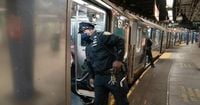On October 16, 2025, a federal judge in Manhattan delivered a decisive blow to the Trump administration’s efforts to withhold nearly $34 million in anti-terrorism funding from New York City’s transit system. The ruling, handed down by Judge Lewis A. Kaplan, not only restored the crucial funds but also ignited a broader debate about the intersection of immigration policy, public safety, and federal authority in the nation’s most populous city.
The controversy centered on the Transit Security Grant Program, a post-9/11 initiative established to fortify the nation’s most vulnerable transportation networks against terrorist threats. As Judge Kaplan noted in his 28-page decision, the program was created with a singular aim: to allocate money "solely on the basis of terrorism risk." New York City, home to the Metropolitan Transportation Authority (MTA) and the site of the deadliest terrorist attack on American soil, has long been a primary recipient of these grants. The city’s intricate web of subways, bridges, and tunnels has made it a perennial target, with at least eight known terrorist plots against its transit system since 2001, according to the New York Daily News.
But on the eve of the new federal fiscal year, the Trump administration announced it would eliminate the funding for the MTA, citing New York’s “sanctuary city” protections for undocumented immigrants as the justification. FEMA, the Federal Emergency Management Agency, disclosed in court filings that the transit authority "did not receive funding because the applicant is based in New York City, a designated Sanctuary Jurisdiction city." The move, as reported by Reuters and Daily Kos, was part of a broader policy targeting so-called blue states—those led by Democratic officials—with significant cuts to anti-terrorism grants.
The impact of this decision was immediate and far-reaching. The $33.8 million at stake represented the largest allocation to any transit agency in the country, funding that pays for targeted counterterrorism patrols, advanced security equipment, infrastructure enhancements, cybersecurity technology, and weapons detection systems. NYPD Commissioner Jessica Tisch called the cut a "profound mistake," emphasizing that the money had also supported canine units trained to detect explosives and chemical threats, undercover officers, heavy weapons teams, and an extensive surveillance network throughout the subway system.
In response, New York State, led by Attorney General Letitia James and Governor Kathy Hochul, filed suit against the Department of Homeland Security and FEMA. Their legal argument was straightforward: Congress had explicitly prohibited the Department of Homeland Security from imposing immigration-related conditions on the disbursement of Transit Security Grant Program funds. Instead, recipients were to be selected "based solely on risk," not political considerations or local immigration policies. As Judge Kaplan wrote in his ruling, "Here, Congress did not authorize the DHS Secretary to fix immigration-related terms or conditions on the disbursement of TSGP funds. To the contrary, Congress prohibited DHS from imposing such terms by requiring the selection of grant recipients to be ‘based solely on risk.’"
The Trump administration’s legal team countered that the funds had already lapsed and been obligated to other recipients, and that there was no evidence the decision was arbitrary or capricious. They further argued that the cuts would not cause irreparable harm to New York. Judge Kaplan was not persuaded. He described the administration’s actions as "arbitrary, capricious, and a blatant violation of the law," and issued a permanent injunction against the funding cut.
The ruling was met with swift approval from New York’s leadership. In a joint statement, Governor Hochul and Attorney General James called it "a victory for every New Yorker who rides our subways, buses, and commuter rails." They added, "A court has once again affirmed that this administration cannot punish New York by arbitrarily wiping out critical security resources and defunding law enforcement that keeps riders safe." Hochul went further, accusing the Trump administration of "defunding the police" by targeting funds used to protect millions of daily commuters.
This legal battle was not unique to New York. According to Daily Kos, twelve states led by Democratic officials filed lawsuits to block similar cuts, with the largest reductions proposed for Washington D.C. (70 percent), Illinois (69 percent), California (31 percent), and New Jersey (49 percent). The Trump administration initially attempted to slash 77 percent of New York’s funding but reversed course following the lawsuits. Meanwhile, states that Trump carried in the 2024 election—such as Wisconsin, North Carolina, and Ohio—were slated to receive additional funding, highlighting a partisan pattern in the allocation of federal security resources.
Critics argued that these funding decisions exposed major urban centers—historically the most likely targets of international terrorism—to unnecessary risk. Washington D.C., for example, was targeted by al-Qaida on September 11, 2001, and remains one of the most obvious terrorism targets in the world. The administration’s approach, detractors claimed, put political vendettas above national security, opening the door to what one commentator described as “vindictive targeting of blue states, even if it opens the nation up to more terrorist attacks.”
The debate also touched on broader issues of federalism and the use of federal spending to influence state and local policies. The Trump administration has frequently leveraged federal funds to pressure states on a range of issues, from immigration to public health. In this instance, the tactic ran afoul of explicit congressional intent and the unique vulnerabilities of New York City’s transit system.
For the MTA and its millions of daily riders, the restoration of funding means continued investment in technologies that detect weapons of mass destruction, support for canine units and undercover officers, and the maintenance of a security apparatus that has become essential in the post-9/11 era. As Judge Kaplan observed in his ruling, "In the decades since, New York City has remained a prime target for terrorist attacks. Among the City’s foremost targets are its bridges, tunnels, and subway and commuter rail systems."
The court’s decision, while rooted in the specifics of federal grant law, reverberates far beyond New York. It underscores the delicate balance between national security, immigration policy, and the rule of law, and serves as a reminder that the aftermath of 9/11 continues to shape the nation’s priorities and politics. As the dust settles, New Yorkers can ride the subway with a little more confidence—knowing, at least for now, that vital security measures remain funded, and that the courts have reaffirmed the principle that public safety should not be subject to political whims.

